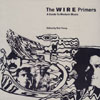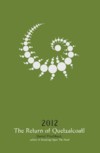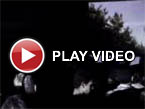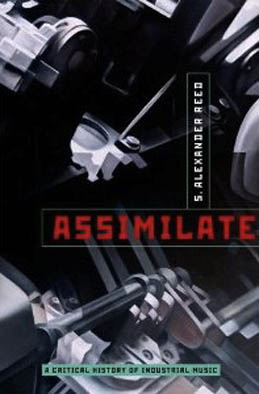 While there have been a few excellent books published about individual bands published over the years (Wreckers of Civilisation and England's Hidden Reverse spring to mind), no one has quite gotten around to writing a definitive history of industrial music yet. Reed, currently a professor of music at Ithaca College, has certainly made a valiant attempt though (and scored a major coup by getting Oxford University Press to put it out as well). Assimilate is essentially half of a truly wonderful book: Reed does a spectacular job chronicling both the formative years of industrial music and its ties to radical art movements, but ultimately gets bogged down a bit in theory and some perplexing choices in focus.
While there have been a few excellent books published about individual bands published over the years (Wreckers of Civilisation and England's Hidden Reverse spring to mind), no one has quite gotten around to writing a definitive history of industrial music yet. Reed, currently a professor of music at Ithaca College, has certainly made a valiant attempt though (and scored a major coup by getting Oxford University Press to put it out as well). Assimilate is essentially half of a truly wonderful book: Reed does a spectacular job chronicling both the formative years of industrial music and its ties to radical art movements, but ultimately gets bogged down a bit in theory and some perplexing choices in focus.
 Joke Lanz has been a constant in the worldwide noise scene for over two decades and has always stood alone as a unique and inventive artist, impossible to pin down but always innovative. This book presents the history of the project, as well as a massive documentation of Lanz's life and prolific performance art career, of which I was less familiar, but found captivated nonetheless.
Joke Lanz has been a constant in the worldwide noise scene for over two decades and has always stood alone as a unique and inventive artist, impossible to pin down but always innovative. This book presents the history of the project, as well as a massive documentation of Lanz's life and prolific performance art career, of which I was less familiar, but found captivated nonetheless.
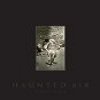 The dream of time travel has been achieved with the spectral photographs presented in this book, a collection of anonymous Hallowe'en pictures from America circa the years 1875 through 1955. Bound in soft black cloth the pages inside are windows onto the ghost memories of America, captured in the twilight years before the Hallowe'en had become fodder for a Hallmark industry churning out cards, candy and plastic decorations. This assemblage of photos portraying kids and adults dressed up as ghosts, witches, scarecrows, skeletons, animals, monsters, and stranger inexplicable beings shows unequivocally the thin line between life and death, reverence and revelry the day is known for. In bringing them all together some of Hallowe'ens primal atavism is restored.
The dream of time travel has been achieved with the spectral photographs presented in this book, a collection of anonymous Hallowe'en pictures from America circa the years 1875 through 1955. Bound in soft black cloth the pages inside are windows onto the ghost memories of America, captured in the twilight years before the Hallowe'en had become fodder for a Hallmark industry churning out cards, candy and plastic decorations. This assemblage of photos portraying kids and adults dressed up as ghosts, witches, scarecrows, skeletons, animals, monsters, and stranger inexplicable beings shows unequivocally the thin line between life and death, reverence and revelry the day is known for. In bringing them all together some of Hallowe'ens primal atavism is restored.
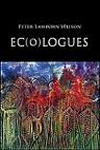 Sometimes the words of Peter Lamborn Wilson feel like a cattle prod but here they are more akin to a shepard's walking stick. He doesn't use them to steer people further into the herd mentality, but to lead, and perhaps seduce, readers into pastures that are altogether much more verdant, free, and open. The poems and essays in this book are not the idylls of the king, or any ruling class. Rather they praise the swampy haunts of lazy fishermen who do more beer drinking than line casting and celebrate feral children revolting against a decayed suburbia. And while they take their cue from the Eclogues of Virgil, those being a type of buccolic poetry depicting rustic subjects and the care of cattle, Wilson makes a definite link between being idle, idyllic poetry, and a form of idolatry that is insurrectionist in its connotations.
Sometimes the words of Peter Lamborn Wilson feel like a cattle prod but here they are more akin to a shepard's walking stick. He doesn't use them to steer people further into the herd mentality, but to lead, and perhaps seduce, readers into pastures that are altogether much more verdant, free, and open. The poems and essays in this book are not the idylls of the king, or any ruling class. Rather they praise the swampy haunts of lazy fishermen who do more beer drinking than line casting and celebrate feral children revolting against a decayed suburbia. And while they take their cue from the Eclogues of Virgil, those being a type of buccolic poetry depicting rustic subjects and the care of cattle, Wilson makes a definite link between being idle, idyllic poetry, and a form of idolatry that is insurrectionist in its connotations.
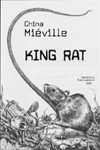 This novel is a resplendent supernatural tale moving to the brain rattling pulse of Jungle and Drum 'n Bass. These musical styles are the natural soundtrack for the book which was published when they were reaching an apex of popularity and polish in the late '90s. The arc of the story follows the deep bass tones of the genre, reverberating into the underworld of the sewers, and clamoring with explosive hi-hat snaps and brittle piano rolls onto the tarmac and slate roofed tops of London, where the book is set. This is a city book about city music crafted in apartments and blasted from cars, boom boxes, and sound systems smuggled into disused warehouses. This is a city book about city rodents sniffling through back alleys, searching refuse bins for a bit of scran, trying to avoid the daylight eyes of the human population. It is a book that agitated my mind in a most delightful way, as it has always been my opinion that good fiction–and music—should uproot the moorings of reality. This book did so with thunderous quakes and rhythmic undulations.
This novel is a resplendent supernatural tale moving to the brain rattling pulse of Jungle and Drum 'n Bass. These musical styles are the natural soundtrack for the book which was published when they were reaching an apex of popularity and polish in the late '90s. The arc of the story follows the deep bass tones of the genre, reverberating into the underworld of the sewers, and clamoring with explosive hi-hat snaps and brittle piano rolls onto the tarmac and slate roofed tops of London, where the book is set. This is a city book about city music crafted in apartments and blasted from cars, boom boxes, and sound systems smuggled into disused warehouses. This is a city book about city rodents sniffling through back alleys, searching refuse bins for a bit of scran, trying to avoid the daylight eyes of the human population. It is a book that agitated my mind in a most delightful way, as it has always been my opinion that good fiction–and music—should uproot the moorings of reality. This book did so with thunderous quakes and rhythmic undulations.
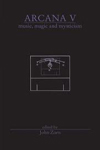 The fifth installment in John Zorn's ongoing series anthologizing the writings, reflections, and critical insights of contemporary musicians and composers tackles subjects that are usually brushed aside in academic music journals, namely the occult. It is no secret that musicians, from time immemorial, have approached their art as if they were approaching the sacred. Magic and mysticism are twin strands woven into the fabric of musical history and they continue to excite new developments within the music of the present day. The numinous gets lip service in popular culture when the likes of Madonna parade their studies of Kabbalah, making the pursuit of arcane knowledge more of a fashion statement then an actual path and discipline. The best of independent music however has never shied away from being overtly esoteric, and is not watered down to suit the masses or make it more palatable to undiscerning ears. This book brings together essential writings from those who are comfortably at home in the intersection of magic and music, that liminal zone accessed by shamans and session players alike. As such it is a welcome addition to the library of not only the musical aspirant, but the magical as well.
The fifth installment in John Zorn's ongoing series anthologizing the writings, reflections, and critical insights of contemporary musicians and composers tackles subjects that are usually brushed aside in academic music journals, namely the occult. It is no secret that musicians, from time immemorial, have approached their art as if they were approaching the sacred. Magic and mysticism are twin strands woven into the fabric of musical history and they continue to excite new developments within the music of the present day. The numinous gets lip service in popular culture when the likes of Madonna parade their studies of Kabbalah, making the pursuit of arcane knowledge more of a fashion statement then an actual path and discipline. The best of independent music however has never shied away from being overtly esoteric, and is not watered down to suit the masses or make it more palatable to undiscerning ears. This book brings together essential writings from those who are comfortably at home in the intersection of magic and music, that liminal zone accessed by shamans and session players alike. As such it is a welcome addition to the library of not only the musical aspirant, but the magical as well.
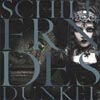 A mystique of magic has lurked around books since the first scrolls were inked. Today a well made tome can hold just as much fascination. The one I hold in my hands casts a hypnotic spell as it looks back over the history of what has been termed the dark scene or dark culture. Editor Alexander Nym argues that the differences between the various subcultures surrounding industrial, gothic, darkwave and black metal music are all superficial, and that they share a number of common aesthetic positions. Looking through the 800 plus photographs in this book, many published here for the first time, it is easy to see that this is the case.
A mystique of magic has lurked around books since the first scrolls were inked. Today a well made tome can hold just as much fascination. The one I hold in my hands casts a hypnotic spell as it looks back over the history of what has been termed the dark scene or dark culture. Editor Alexander Nym argues that the differences between the various subcultures surrounding industrial, gothic, darkwave and black metal music are all superficial, and that they share a number of common aesthetic positions. Looking through the 800 plus photographs in this book, many published here for the first time, it is easy to see that this is the case.
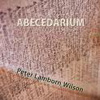 As most elementary school kids know the letters of the alphabet are the building blocks used to construct tiny words, big words, made up words; with a dash of punctuation entire sentences can be built from letters making up short articles like this one or filling up volumes to create massive epic narratives or turgid philosophical treatises. Yet like the atoms that make up our universe the letters of the alphabet contain within them subatomic particles and secret histories. Peter Lamborn Wilson has done a remarkable service in teasing out the ghosts trapped within the Roman letters by tracing them back to more arcane iconographies, all the while giving a reminder that when writing originated it was considered a magical art, and one closely allied with statecraft. While those two functions have not disappeared they have been (deliberately) obscured as the symbols transformed over time.
As most elementary school kids know the letters of the alphabet are the building blocks used to construct tiny words, big words, made up words; with a dash of punctuation entire sentences can be built from letters making up short articles like this one or filling up volumes to create massive epic narratives or turgid philosophical treatises. Yet like the atoms that make up our universe the letters of the alphabet contain within them subatomic particles and secret histories. Peter Lamborn Wilson has done a remarkable service in teasing out the ghosts trapped within the Roman letters by tracing them back to more arcane iconographies, all the while giving a reminder that when writing originated it was considered a magical art, and one closely allied with statecraft. While those two functions have not disappeared they have been (deliberately) obscured as the symbols transformed over time.
 Along with the "Invisible Jukebox" feature, The Wire’s "Primer" articles are one of the best things about the magazine. While this collection deals mainly in the better known end of The Wire’s remit, I found plenty of areas where my previous knowledge had been vague to say the least. Even considering not all the articles in this book were of particular interest, most of them were of a standard that left me wanting to listen to the music described and dissected within which is something that music journalism does not always manage to do.
Along with the "Invisible Jukebox" feature, The Wire’s "Primer" articles are one of the best things about the magazine. While this collection deals mainly in the better known end of The Wire’s remit, I found plenty of areas where my previous knowledge had been vague to say the least. Even considering not all the articles in this book were of particular interest, most of them were of a standard that left me wanting to listen to the music described and dissected within which is something that music journalism does not always manage to do.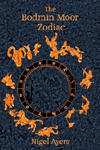 Since 2006 Nigel Ayers work has been focused on the investigation of folklore and geography of place, specifically his home in Cornwall, England. As part of his ongoing guerilla sign ontology campaign to boycott consensus reality he undertook a series of ritual walks into Cornwall’s sacred landscape, documented in this book from 2007. Part narrative essay and part scientific log, with ample photographic evidence provided by his wife Lesley, it follows Nigel’s journey into the Otherworld through the zodiac gateways of the Bodmin Moor.
Since 2006 Nigel Ayers work has been focused on the investigation of folklore and geography of place, specifically his home in Cornwall, England. As part of his ongoing guerilla sign ontology campaign to boycott consensus reality he undertook a series of ritual walks into Cornwall’s sacred landscape, documented in this book from 2007. Part narrative essay and part scientific log, with ample photographic evidence provided by his wife Lesley, it follows Nigel’s journey into the Otherworld through the zodiac gateways of the Bodmin Moor.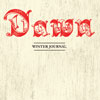 Of all the reasons to visit Bodo Norway, personal crisis must be among the rarest. Nevertheless, in 2002 Phil Elverum (of Mount Eerie and the Microphones) spent the winter there to recover from a personal and artistic meltdown. Not one for a simple vacation, he stayed alone in a cabin a few hours outside the city. He passed the time writing songs, reading, and putting down his thoughts in a journal. Those journal entries make up Dawn, along with a collection of cartoons, photographs, and a CD of music he recorded during his stay.
Of all the reasons to visit Bodo Norway, personal crisis must be among the rarest. Nevertheless, in 2002 Phil Elverum (of Mount Eerie and the Microphones) spent the winter there to recover from a personal and artistic meltdown. Not one for a simple vacation, he stayed alone in a cabin a few hours outside the city. He passed the time writing songs, reading, and putting down his thoughts in a journal. Those journal entries make up Dawn, along with a collection of cartoons, photographs, and a CD of music he recorded during his stay. To celebrate the release of the three Angry Eelectric Finger albums several years back, Steven Stapleton salvaged paint and vinyl from a landfill and turned them into 100 paintings that were displayed in galleries in Ireland and Portland. Years in the making, all of these paintings are finally collected here in one hardbound volume. This lavish package also comes with the original source material on CD for the first time as well as an additional disc of music, making this one of Nurse With Wound’s finest releases to date.
To celebrate the release of the three Angry Eelectric Finger albums several years back, Steven Stapleton salvaged paint and vinyl from a landfill and turned them into 100 paintings that were displayed in galleries in Ireland and Portland. Years in the making, all of these paintings are finally collected here in one hardbound volume. This lavish package also comes with the original source material on CD for the first time as well as an additional disc of music, making this one of Nurse With Wound’s finest releases to date.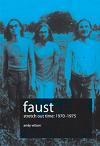 Andy Wilson has top notch credentials when it comes to Faust. For years he has been running the Faust Pages, the online Mecca for all things Faustian. The semi-official nature of this site means that he has had good contact with the various members of Faust and presumably he is in a good position to put together a decent biography of the band. Unfortunately Faust: Stretch Out Time 1970-1975 is a disappointing read. There is not enough focus on the band's history, instead Wilson spends more time giving his opinions and descriptions of songs that I suspect most readers of his book will already know intimately.
Andy Wilson has top notch credentials when it comes to Faust. For years he has been running the Faust Pages, the online Mecca for all things Faustian. The semi-official nature of this site means that he has had good contact with the various members of Faust and presumably he is in a good position to put together a decent biography of the band. Unfortunately Faust: Stretch Out Time 1970-1975 is a disappointing read. There is not enough focus on the band's history, instead Wilson spends more time giving his opinions and descriptions of songs that I suspect most readers of his book will already know intimately.Co-founder of The Idler magazine has written a charming book full of science, myth, wit and nuance. Thankfully more of an artistic, spiritual, and cultural history, than a mere guide to identify types of clouds.
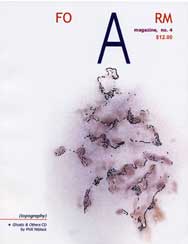 Approaching its fifth edition, FO(A)RM is a interdisciplinary magazine published annually by
Mathew Marble, Bethany Wright and Seth Nehil.
The text incorporates and fuses poetry, visual art, graphic scoring,
scholastic essays, dialogue, fiction, and is typically accompanied by a disc of
sound media, often particularly exciting given the frequency at which sound
artists appear in the magazine. Each
issue has a thematic locus, this 2005 edition’s being topography, a group of
ideas that should come as no surprise to those familiar at least with Nehil,
whose recorded work alone and with artists like Mnortham, Jgriznich, and the Orogenetics
collective draw heavily from landscape and natural spaces.
Approaching its fifth edition, FO(A)RM is a interdisciplinary magazine published annually by
Mathew Marble, Bethany Wright and Seth Nehil.
The text incorporates and fuses poetry, visual art, graphic scoring,
scholastic essays, dialogue, fiction, and is typically accompanied by a disc of
sound media, often particularly exciting given the frequency at which sound
artists appear in the magazine. Each
issue has a thematic locus, this 2005 edition’s being topography, a group of
ideas that should come as no surprise to those familiar at least with Nehil,
whose recorded work alone and with artists like Mnortham, Jgriznich, and the Orogenetics
collective draw heavily from landscape and natural spaces. 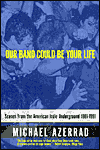 This book covers the history of a quite a few (but by no means a
complete listing of) important indie/punk/hardcore bands: Butthole
Surfers, Mission of Burma, Minutemen, Sonic Youth, Big Black, Dinosaur
Jr., Black Flag, Minor Threat, Fugazi, Husker Du, The Replacements,
Beat Happening and Mudhoney. Those who are into any of the bands
covered by this book should probably at least flip through it in a
bookstore. The danger of course is that reading something about a
moderately unfamiliar band can lead to fondness and back catalogue
purchases of bands long ignored or simply missed the first time around.
I am now the proud owner of Mission of Burma's oeuvre (as well as a
bunch of other albums I hadn't heard before). Overall the book is an
entertaining read, but uneven. Some band's chapters are rock solid and
a good read all throughout — Butthole Surfers' is particularly
entertaining — but some of his choices of focus are unusual (Beat
Happening? WTF?) and flimsy excuses to bring up non-sequiturs
(Mudhoney's chapter is essentially SubPop's chapter, really). Minor
Threat AND Fugazi getting separate chapters seemed overkill to me, and
there are notable absences in the stories — I understand that maybe
Gibby Haynes or whoever, didn't want to give an interview, but there
are repeated instances of missing members from bands (no Chuck Dukowski
of Black Flag, or George Hurley from the Minutemen) as well as quite a
few bands that should have been mentioned that weren't (no Bad Brains,
Dead Kennedy's, Meat Puppets, Pixies, The Melvins, Circle Jerks, X,
Germs, Descendents, SWANS, Flaming Lips or Misfits). Which isn't to say
that the book is bad; it's just not as good or complete as I would have
liked. When Azerrad is on, the storytelling can be quite engaging and
will, as I say, make any reader eager to be listening to the music
that's being described. When he's not on, the writing is just dull.
It's worth looking at, but it's not a be-all end-all book about the
indie scene in the 80's and if I had my 'druthers there'd be a second
book featuring the bands he missed in this book.
This book covers the history of a quite a few (but by no means a
complete listing of) important indie/punk/hardcore bands: Butthole
Surfers, Mission of Burma, Minutemen, Sonic Youth, Big Black, Dinosaur
Jr., Black Flag, Minor Threat, Fugazi, Husker Du, The Replacements,
Beat Happening and Mudhoney. Those who are into any of the bands
covered by this book should probably at least flip through it in a
bookstore. The danger of course is that reading something about a
moderately unfamiliar band can lead to fondness and back catalogue
purchases of bands long ignored or simply missed the first time around.
I am now the proud owner of Mission of Burma's oeuvre (as well as a
bunch of other albums I hadn't heard before). Overall the book is an
entertaining read, but uneven. Some band's chapters are rock solid and
a good read all throughout — Butthole Surfers' is particularly
entertaining — but some of his choices of focus are unusual (Beat
Happening? WTF?) and flimsy excuses to bring up non-sequiturs
(Mudhoney's chapter is essentially SubPop's chapter, really). Minor
Threat AND Fugazi getting separate chapters seemed overkill to me, and
there are notable absences in the stories — I understand that maybe
Gibby Haynes or whoever, didn't want to give an interview, but there
are repeated instances of missing members from bands (no Chuck Dukowski
of Black Flag, or George Hurley from the Minutemen) as well as quite a
few bands that should have been mentioned that weren't (no Bad Brains,
Dead Kennedy's, Meat Puppets, Pixies, The Melvins, Circle Jerks, X,
Germs, Descendents, SWANS, Flaming Lips or Misfits). Which isn't to say
that the book is bad; it's just not as good or complete as I would have
liked. When Azerrad is on, the storytelling can be quite engaging and
will, as I say, make any reader eager to be listening to the music
that's being described. When he's not on, the writing is just dull.
It's worth looking at, but it's not a be-all end-all book about the
indie scene in the 80's and if I had my 'druthers there'd be a second
book featuring the bands he missed in this book. Although they are perhaps the most consistently innovative group of
artists for the past two decades of underground music, the English
post-industrial bands that evolved from the cultural monolith of
Throbbing Gristle have long remained under the radar of the music
press. Many of these "esoteric" artists thrived throughout the 1980s
and have persisted until today, but most have been ignored by critics
and writers, surviving only because of a loyal cult following bordering
on the zealous. Only recently have established publications such as The Wire
begun to validate these artists by documenting their activities and
placing their music into the larger context of modern avant-garde
experimentalism. Anyone who has followed these unique musicians knows
that this attention is long overdue. David Keenan, a frequent
contributor to The Wire and Mojo, has authored England's Hidden Reverse.
Subtitled "A Secret History of the Esoteric Underground," Keenan has
chosen to focus on the scene's three most enduring artists—Current 93,
Nurse With Wound and Coil. The story of these three is told in
chronological order, with Keenan attempting to give equal coverage to
each. The prevailing thesis of his book is that David Tibet, Steven
Stapleton, John Balance, and Sleazy Christopherson are not
idiosyncratic madmen that fell from the sky, but are rather quite
naturally following in the footsteps of a long line of English
eccentrics and outsiders. To support this contention, Keenan takes the
reader for many tangential side-trips, telling the stories of great and
obscure figures such as Louis Wain, Aleister Crowley, Austin Osman
Spare, William Lawes, Eric Count Stenbock and a host of others. It
provides interesting background information, quite valuable for a
deeper understanding of many of the lyrical themes of Current 93, the
occult influences on Coil and the surrealist aesthetic of Nurse With
Wound. For fans of these artists who have already digested the numerous
interviews, fanzines and website material that has been available for
years, this book offers a treasure trove of completely new revelations.
Some of the startling anecdotes revealed in the book are truly
unbelievable, such as the first meeting between David Tibet and Jhon
Balance (which I won't reveal, except to say that it involves someone
getting urinated on). Keenan does an admirable job of placing these
musicians into the context of the post-industrial scene, giving a
liberal amount of time to trace their connection to concurrent acts
like Whitehouse, Psychic TV, 23 Skidoo and Sol Invictus. Keenan has
interviewed a staggering number of the people who were there—the
musicians, the scenesters and the witnesses—and the substantial amount
of direct quotes lends credibility to the project. The book is
copiously illustrated with hundreds of previously unpublished
photographs. Although it is unmistakably a thorough study, there are a
few nagging problems with England's Hidden Reverse. Among these
is the disproportionate amount of time spent on the formative period of
the timeline, to the detriment of the last decade of activity, which is
the most fertile creative period for these artists. Latter-day
masterpieces like Current 93's All The Pretty Little Horses and Coil's Musick to Play in the Dark
are given only a few paragraphs each, which is unequal to their
significance. Perhaps the most flagrant problem with this book is the
near-total absence of any material regarding one of the best and
brightest of the esoteric scene: Douglas Pearce. Death in June most
certainly exerted a hefty influence on the development of Current 93's
brand of "apocalyptic folk." Before David Tibet met Douglas P., his
music was all tape loops and dense noisescapes. After their
partnership, Current 93 adopted Death in June's approach, appropriating
the sounds and aesthetics of 1960s psychedelic folk. Despite all this,
and the fact that David Tibet and John Balance have frequently
collaborated with Death in June over the years, Douglas P. was not
interviewed for the book and his influence and importance in the scene
is played down. Certainly Death in June's But, What Ends When the Symbols Shatter? and Rose Clouds of Holocaust are as epoch-defining as Current 93's Thunder Perfect Mind, Nurse With Wound's Soliloquy for Lilith and Coil's Love Secret Domain.
Despite these glaring omissions, David Keenan's book is certainly an
entertaining and essential document. Even those who are not already
ardent fans will find much to like about Keenan's engaging prose and
analysis. Also included with each hardcover edition is a CD collecting
some of the most representative tracks from the three groups. All
things considered, England's Hidden Reverse exceeds expectations as a captivating history of the most unique grouping of experimental musicians working today.
Although they are perhaps the most consistently innovative group of
artists for the past two decades of underground music, the English
post-industrial bands that evolved from the cultural monolith of
Throbbing Gristle have long remained under the radar of the music
press. Many of these "esoteric" artists thrived throughout the 1980s
and have persisted until today, but most have been ignored by critics
and writers, surviving only because of a loyal cult following bordering
on the zealous. Only recently have established publications such as The Wire
begun to validate these artists by documenting their activities and
placing their music into the larger context of modern avant-garde
experimentalism. Anyone who has followed these unique musicians knows
that this attention is long overdue. David Keenan, a frequent
contributor to The Wire and Mojo, has authored England's Hidden Reverse.
Subtitled "A Secret History of the Esoteric Underground," Keenan has
chosen to focus on the scene's three most enduring artists—Current 93,
Nurse With Wound and Coil. The story of these three is told in
chronological order, with Keenan attempting to give equal coverage to
each. The prevailing thesis of his book is that David Tibet, Steven
Stapleton, John Balance, and Sleazy Christopherson are not
idiosyncratic madmen that fell from the sky, but are rather quite
naturally following in the footsteps of a long line of English
eccentrics and outsiders. To support this contention, Keenan takes the
reader for many tangential side-trips, telling the stories of great and
obscure figures such as Louis Wain, Aleister Crowley, Austin Osman
Spare, William Lawes, Eric Count Stenbock and a host of others. It
provides interesting background information, quite valuable for a
deeper understanding of many of the lyrical themes of Current 93, the
occult influences on Coil and the surrealist aesthetic of Nurse With
Wound. For fans of these artists who have already digested the numerous
interviews, fanzines and website material that has been available for
years, this book offers a treasure trove of completely new revelations.
Some of the startling anecdotes revealed in the book are truly
unbelievable, such as the first meeting between David Tibet and Jhon
Balance (which I won't reveal, except to say that it involves someone
getting urinated on). Keenan does an admirable job of placing these
musicians into the context of the post-industrial scene, giving a
liberal amount of time to trace their connection to concurrent acts
like Whitehouse, Psychic TV, 23 Skidoo and Sol Invictus. Keenan has
interviewed a staggering number of the people who were there—the
musicians, the scenesters and the witnesses—and the substantial amount
of direct quotes lends credibility to the project. The book is
copiously illustrated with hundreds of previously unpublished
photographs. Although it is unmistakably a thorough study, there are a
few nagging problems with England's Hidden Reverse. Among these
is the disproportionate amount of time spent on the formative period of
the timeline, to the detriment of the last decade of activity, which is
the most fertile creative period for these artists. Latter-day
masterpieces like Current 93's All The Pretty Little Horses and Coil's Musick to Play in the Dark
are given only a few paragraphs each, which is unequal to their
significance. Perhaps the most flagrant problem with this book is the
near-total absence of any material regarding one of the best and
brightest of the esoteric scene: Douglas Pearce. Death in June most
certainly exerted a hefty influence on the development of Current 93's
brand of "apocalyptic folk." Before David Tibet met Douglas P., his
music was all tape loops and dense noisescapes. After their
partnership, Current 93 adopted Death in June's approach, appropriating
the sounds and aesthetics of 1960s psychedelic folk. Despite all this,
and the fact that David Tibet and John Balance have frequently
collaborated with Death in June over the years, Douglas P. was not
interviewed for the book and his influence and importance in the scene
is played down. Certainly Death in June's But, What Ends When the Symbols Shatter? and Rose Clouds of Holocaust are as epoch-defining as Current 93's Thunder Perfect Mind, Nurse With Wound's Soliloquy for Lilith and Coil's Love Secret Domain.
Despite these glaring omissions, David Keenan's book is certainly an
entertaining and essential document. Even those who are not already
ardent fans will find much to like about Keenan's engaging prose and
analysis. Also included with each hardcover edition is a CD collecting
some of the most representative tracks from the three groups. All
things considered, England's Hidden Reverse exceeds expectations as a captivating history of the most unique grouping of experimental musicians working today.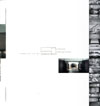 Wollscheid might be best known for his musical work with P16.D4,
Merzbow, or Asmus Tietchens, but in fact this is already the his third
book, presented both in English and German. With this
attractively-designed 100 page paperback, he draws a resume from 7
years work on an interactive computer-light installation piece in an
public space; the district court in Frankfurt am Main. Everything is
documented, from the original concept up to the final realization in a
different building, all the technical difficulties, concluding with the
writing of the book. Plenty of photographs are included (10 color, 43
blue-on-white), from a ceiling light piece to a light-flooded floor. In
addition, explanations are thoroughly presented in a very
understandable manner, both technically and conceptually.
Wollscheid might be best known for his musical work with P16.D4,
Merzbow, or Asmus Tietchens, but in fact this is already the his third
book, presented both in English and German. With this
attractively-designed 100 page paperback, he draws a resume from 7
years work on an interactive computer-light installation piece in an
public space; the district court in Frankfurt am Main. Everything is
documented, from the original concept up to the final realization in a
different building, all the technical difficulties, concluding with the
writing of the book. Plenty of photographs are included (10 color, 43
blue-on-white), from a ceiling light piece to a light-flooded floor. In
addition, explanations are thoroughly presented in a very
understandable manner, both technically and conceptually.Wollscheid says, "I'm convinced that contemporary artistic work which includes electronic data-processing has to be interactive, it should at least implicitly employ the repertoire of interactive processes and concepts." As with any good experimental art, questions are raised. What I'm wondering now is what practical use could develop out of the human / data-processing interface and where will it lead to ?










